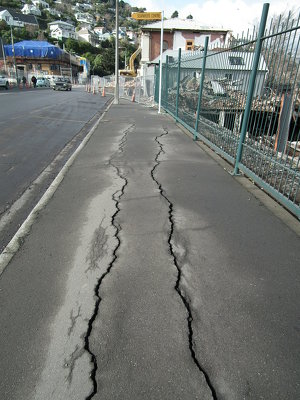
Damage from the Christchurch 7.1 earthquake on 4th Sept 2010

Damage to the Coastguard Building in Kaiapoi. One of the concrete panels on the footpath has lifted, revealing an empty space underneath.

The Williams Street Bridge in Kaiapoi. This part of the footpath was damaged when the concrete abutment rose during the earthquake, forcing its way through the pavement and into the open. Fencing has been placed around this section of the bridge until work can be done to make it safe to walk on.

The footpath on Williams Street bridge in Kaiapoi. Since the earthquake, it has been re-instated after new pipes were laid.

The flood bank is being completely repaired on Raven Quay in Kaiapoi.

The footpath in front of a building on Williams Street. As the building subsided it took part of the path with it. This gives an idea of how much this commercial building sank due to liquefaction.

Buckled curbing along Jones Street in Kaiapoi. A pile of liquefaction can be seen in the foreground as well as a few plastic pipes. A number of portaloos line the street in the distance as well as road cones.

In front of the Williams Street Bridge in Kaiapoi. This part of the footpath was damaged when the concrete abutment rose during the earthquake, forcing its way through the pavement and into the open. Fencing has been placed around this section of the bridge until work can be done to make it safe to walk on.

A cracked and broken footpath on Galbraith Avenue. Blue pipes carrying temporary water supplies to the neighbourhood can just be seen running beside the footpath.

Cracking in the land next to the Williams Street bridge in Kaiapoi, still not filled in. Tape has been placed on the fence posts to keep people away.

A crack between the river bank and the footpath near the Williams Street Bridge in Kaiapoi. This crack has now largely been filled in. The visible gap shows how much the land slipped towards the river during the earthquake.

An area next to the river in Kaiapoi where workers previously dug trenches to fix the power and communication lines. They have now been fixed and the trenches have been filled in. A pile of dirt can still be seen.

Cracking on the footpath in a residental area.

Corcoron French Lawyers on Williams Street in Kaiapoi. Liquefaction has caused the building to sink on the right side. This is shown by the fence which now sits at an angle. The building occupiers have now moved to 17 Sewell Street, a sign on the door saying "Corcoron French Lawyers, We have moved to temporary premises, 17 Sewell Street, Opposite Kaiapoi Community Centre".

The basement of a building in Kaiapoi, the ceiling collapsed in the corner. The top two stories of the building were structurally compromised and have been demolished.

The wooden foot bridge over the Kaiapoi River. Slumping between the abutments can be seen.

Sewage continues to be pumped into the river while the damaged sewerage system is repaired.

A photograph of crumpled pavement on a footpath where the ground underneath has lifted during the earthquake.

Emergency Police tape placed over a footpath. The footpath is covered in broken glass from a smashed window.

A photograph of cracking in the footpath near a bus stop on Gayhurst Road.

A photograph of cracking in the footpath near a bus stop on Gayhurst Road.

A crack in the footpath in Avonside with cones around it to warn pedestrians and cyclists.

A photograph of silt from liquefaction and a cracked footpath near a drain on Gayhurst Road.

Damaged footpath in Lyttelton.

This was a footpath.

A photograph of the earthquake damage to the footpath before the Williams Street bridge in Kaiapoi, over the Kaiapoi River.

The footpath on Williams Street bridge in Kaiapoi. Since the earthquake, it has been re-instated after new pipes were laid.

A photograph of children walking home from school along Gayhurst Road. A crack can be seen running across the footpath.

A photograph of children walking home from school along Gayhurst Road. A crack can be seen running across the footpath.

The footpath is just new.
